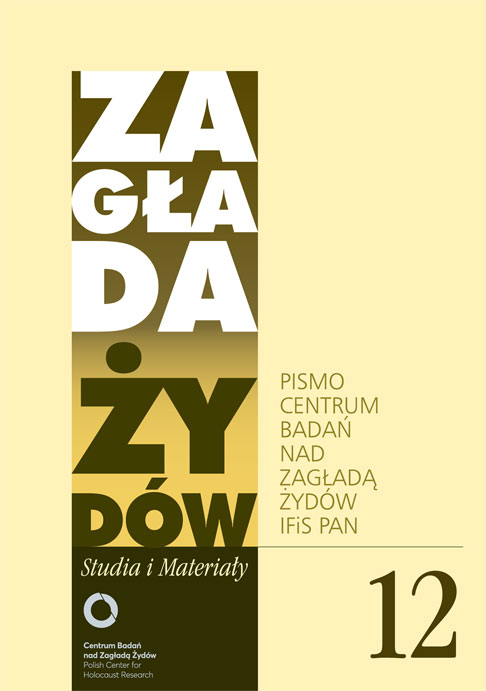Frankenstein w warszawskim getcie. Historia i legenda
Zagłada Żydów. Studia i Materiały, Nr 12 (2016), Strony: 187-208
Data zgłoszenia: 2020-10-19Data publikacji: 2016-11-30
 https://doi.org/10.32927/ZZSiM.414
https://doi.org/10.32927/ZZSiM.414
Abstrakt
The article deals with one exceptionally violent German perpetrator who was part of the occupation force in Warsaw during the Second World War. Inside the Ghetto he maltreated and killed a large number of women, children and men for his own personal pleasure. He did this to such an extensive degree that the population perceived him as monstrous being that was given the nickname „Frankenstein”. The article is mainly based on statements in juridical investigations, from the victim as well as from the perpetrator perspective, supplemented with some selected additional sources. Firstly the source corpus will be evaluated, to work out how these historical sources can be used to shed light on „Frankenstein”. This will be followed by an analysis of the actual identity of this perpetrator. It will be shown that he was, contrary to common belief, not necessarily the SS-Rottenführer Josef Blösche but more likely a member of the German Police Battalion 61. In the end the question will be also raised of how it was possible – despite all rules and regulations – that ghetto guards like him behaved like a marauding soldiery.
Słowa kluczowe
getto warszawskie , Zagłada , policja umundurowana , zbrodnie okupacyjne , warty w getcie , batalion policyjny , sprawca , przemoc , strach , terror , życie w getcie
Licencja
Prawa autorskie (c) 2016 Autor&"Zagłada Żydów. Studia i Materiały"

Utwór dostępny jest na licencji Creative Commons Uznanie autorstwa 4.0 Międzynarodowe.
https://creativecommons.org/licenses/by/4.0
Czasopismo publikowane jest w standardzie Diamond Open Access na licencji CC-BY-4.0 Deed - Uznanie autorstwa 4.0 Międzynarodowa - Creative Commons
Podobne artykuły
- Martyna Grądzka-Rejak, Jan Olaszek, Postawy i zachowania Polaków wobec Żydów w czasie okupacji niemieckiej w publikacjach drugiego obiegu w PRL , Zagłada Żydów. Studia i Materiały: Nr 15 (2019)
- Agnieszka Haska, Yorai Linenberg, Jewish Soldiers in Nazi Captivity: American and British Prisoners of War during the Second World War , Zagłada Żydów. Studia i Materiały: Nr 20 (2024)
- Adam Puławski, Magdalena Hułas (red.), współpraca Piotr Długołęcki, Polskie Dokumenty Dyplomatyczne 1942 , Zagłada Żydów. Studia i Materiały: Nr 20 (2024)
- Tom Navon, Avinoam J. Patt, The Jewish Heroes of Warsaw: The Afterlife of the Revolt , Zagłada Żydów. Studia i Materiały: Nr 20 (2024)
- Maria Ferenc, Aleksandra Bańkowska, „Czy może być jakieś odszkodowanie moralne za zatarcie wszelkich śladów tysiącletniego istnienia Żydów w Polsce?” Nieznane pisma Emanuela Ringelbluma z 1943 r. , Zagłada Żydów. Studia i Materiały: Nr 20 (2024)
- Zofia Trębacz, Natalia Judzińska, Po lewej stronie sali. Getto ławkowe w międzywojennym Wilnie , Zagłada Żydów. Studia i Materiały: Nr 20 (2024)
- Mirosław Skrzypczyk, Robert Szuchta, Piotr Trojański, Holokaust. (Nie)odrobiona lekcja historii , Zagłada Żydów. Studia i Materiały: Nr 20 (2024)
- Zofia Wóycicka, W poszukiwaniu nowych sposobów na wyrażenie tego, co trudne do pojęcia. Muzea i miejsca pamięci poświęcone Zagładzie w XXI w. , Zagłada Żydów. Studia i Materiały: Nr 20 (2024)
- Marta Tomczok, Literatura polska wobec Zagłady 2000 – 2024. Bilans subiektywny , Zagłada Żydów. Studia i Materiały: Nr 20 (2024)
- Adam Kopciowski, Anti-Jewish Incidents in the Lublin Region in the Early Years after World War II , Zagłada Żydów. Studia i Materiały: 2008: Holocaust Studies and Materials
<< < 17 18 19 20 21 22 23 24 25 26 27 28 29 30 31 32 33 34 35 36 37 38 39 40 41 42 43 44 45 46 47 48 49 50 51 52 53 54 55 56 57 > >>
Możesz również Rozpocznij zaawansowane wyszukiwanie podobieństw dla tego artykułu.
 English
English
 Język Polski
Język Polski




